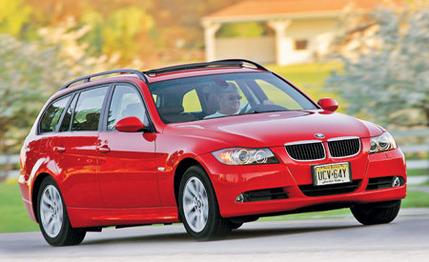 Short Take Road Test
Short Take Road Test
This is a station wagon only in the loosest use of the term. BMW says "sports wagon."
Americans mostly don't pick up on that idea. When we see that long, high roofline, we think mommymobile. But this tightly wrapped Bimmer is not about hauling the Pampers and Puppy Chow home from Costco, not with just 107 cubic feet of interior space (compared with a PT Cruiser at 121).
More than anything, this 325xi reminds of a high-tail coupe. The roof carves down in back and wraps low on the sides, cropping the passengers' view, trimming it to narrow slots all around. There's space for two in back, if they fit the "active adult" template. The rear wheels crowd into the outer boundaries of the seats, forcing the seated toward the tunnel. Their tennis equipment piles easily in the 16 cubic feet behind the seats, and maybe there's room for a picnic lunch, too. But this mobile is much more about driving than wagoning.
You feel athletic suspension motions, deliberate steering responses, a stiff clutch, and a taut gear lever - all united by a rigid body structure. This is a car that does nothing till you put some muscle into it. It expects you to drive.
The 3-series wagon comes in one model only, with all wheels driven by the low-output 215-hp, 3.0-liter six (330i sedans have a 255-hp 3.0-liter). You get six speeds, either manual (as was our test car) or automatic. The new engine is a silken wonder all the way to its 7000-rpm redline, greatly refined but only moderately spirited.
The sports wagon is the heaviest model of the 3-series line; ours weighed 3733 pounds, 273 over our favorite 330i rear-drive four-door. So acceleration falls well behind, reaching 60 in seven seconds flat. You'll find yourself rowing the shifter. The gearing is long-legged, and it's easy to let the wagon's engine drop too low in revs to pull the next grade.
The all-wheel-drive system uses a multi-disc clutch to apportion torque between the front and rear. When the system senses understeer, it directs more torque to the rear, and less to the rear in times of oversteer. This is a fundamentally smart idea. We were blessed with sunny weather during our testing, so our impressions are based on dry handling. There we found well-toned suspension muscles providing firm, stable roll control. Understeer is dependable, as it should be for road driving.
At the skidpad, we measured 0.80 g of cornering grip on the standard 205/55R-16 all-season Bridgestone Turanzas. Run-flat tires are standard equipment; there is no spare.
There's a stern sort of luxury about this car. The interior is mostly black, with brown-shoe brown-colored seats and door inserts. The details show high quality, particularly in the cargo area where the edges of the short-pile carpet are meticulously rolled out of sight and firmly secured. We like the cargo-loading flexibility: Lift the whole hatch lid or just the hinged glass. Both panels of the sunroof tilt, and the bigger one slides open. If the price, $40,190 as tested, seems high, you're probably thinking too much about the "wagon" part and not enough about "sports."